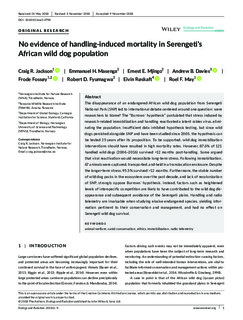| dc.contributor.author | Jackson, Craig Ryan | |
| dc.contributor.author | Masenga, Emmanuel Hosiana | |
| dc.contributor.author | Mjingo, Ernest E. | |
| dc.contributor.author | Davies, Andrew B. | |
| dc.contributor.author | Fossøy, Frode | |
| dc.contributor.author | Fyumagwa, Robert D. | |
| dc.contributor.author | Røskaft, Eivin | |
| dc.contributor.author | May, Roelof Frans | |
| dc.date.accessioned | 2019-02-13T14:51:51Z | |
| dc.date.available | 2019-02-13T14:51:51Z | |
| dc.date.created | 2019-02-01T10:52:28Z | |
| dc.date.issued | 2018 | |
| dc.identifier.issn | 2045-7758 | |
| dc.identifier.uri | http://hdl.handle.net/11250/2585300 | |
| dc.description.abstract | The disappearance of an endangered African wild dog population from Serengeti National Park (SNP) led to international debate centered around one question: were researchers to blame? The “Burrows' hypothesis” postulated that stress induced by research‐related immobilization and handling reactivated a latent rabies virus, eliminating the population. Insufficient data inhibited hypothesis testing, but since wild dogs persisted alongside SNP and have been studied since 2005, the hypothesis can be tested 25 years after its proposition. To be supported, wild dog immobilization interventions should have resulted in high mortality rates. However, 87.6% of 121 handled wild dogs (2006–2016) survived >12 months post‐handling. Some argued that viral reactivation would necessitate long‐term stress. Following immobilization, 67 animals were captured, transported, and held in a translocation enclosure. Despite the longer‐term stress, 95.5% survived >12 months. Furthermore, the stable number of wild dog packs in the ecosystem over the past decade, and lack of recolonization of SNP, strongly oppose Burrows' hypothesis. Instead, factors such as heightened levels of interspecific competition are likely to have contributed to the wild dog disappearance and subsequent avoidance of the Serengeti plains. Handling and radio telemetry are invaluable when studying elusive endangered species, yielding information pertinent to their conservation and management, and had no effect on Serengeti wild dog survival. | nb_NO |
| dc.language.iso | eng | nb_NO |
| dc.publisher | Wiley Open Access | nb_NO |
| dc.rights | Navngivelse 4.0 Internasjonal | * |
| dc.rights.uri | http://creativecommons.org/licenses/by/4.0/deed.no | * |
| dc.title | No evidence of handling‐induced mortality in Serengeti's African wild dog population | nb_NO |
| dc.type | Journal article | nb_NO |
| dc.type | Peer reviewed | nb_NO |
| dc.description.version | publishedVersion | nb_NO |
| dc.source.journal | Ecology and Evolution | nb_NO |
| dc.identifier.doi | 10.1002/ece3.4798 | |
| dc.identifier.cristin | 1671940 | |
| dc.description.localcode | © 2018 The Authors. Ecology and Evolution published by John Wiley & Sons Ltd. This is an open access article under the terms of the Creative Commons Attribution License, which permits use, distribution and reproduction in any medium, provided the original work is properly cited. | nb_NO |
| cristin.unitcode | 194,66,10,0 | |
| cristin.unitname | Institutt for biologi | |
| cristin.ispublished | true | |
| cristin.fulltext | original | |
| cristin.qualitycode | 1 | |

